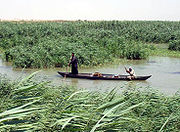
Glory Canal
Encyclopedia

Canal
Canals are man-made channels for water. There are two types of canal:#Waterways: navigable transportation canals used for carrying ships and boats shipping goods and conveying people, further subdivided into two kinds:...
in Iraq
Iraq
Iraq ; officially the Republic of Iraq is a country in Western Asia spanning most of the northwestern end of the Zagros mountain range, the eastern part of the Syrian Desert and the northern part of the Arabian Desert....
about two kilometers wide built by Saddam Hussein
Saddam Hussein
Saddam Hussein Abd al-Majid al-Tikriti was the fifth President of Iraq, serving in this capacity from 16 July 1979 until 9 April 2003...
in 1993 to redirect water flowing from the Tigris
Tigris
The Tigris River is the eastern member of the two great rivers that define Mesopotamia, the other being the Euphrates. The river flows south from the mountains of southeastern Turkey through Iraq.-Geography:...
river into the Euphrates
Euphrates
The Euphrates is the longest and one of the most historically important rivers of Western Asia. Together with the Tigris, it is one of the two defining rivers of Mesopotamia...
, near their confluence at the Shatt al-Arab. It helped cause an environmental and humanitarian disaster since it diverted natural water flow from the Central Marshes
Central Marshes
The Central or Qurna Marshes were a large complex of wetlands in Iraq that were part of the Tigris-Euphrates river system, along with the Hawizeh and Hammar Marshes...
and effectively converted much of the wetlands into a desert
Desert
A desert is a landscape or region that receives an extremely low amount of precipitation, less than enough to support growth of most plants. Most deserts have an average annual precipitation of less than...
. After the First Gulf War, Saddam Hussein aggressively revived a program to divert the flow of the Tigris and the Euphrates
Euphrates
The Euphrates is the longest and one of the most historically important rivers of Western Asia. Together with the Tigris, it is one of the two defining rivers of Mesopotamia...
rivers away from the marshes in retribution for a failed Shia uprising. This directly effected the Marsh Arabs
Marsh Arabs
The Marsh Arabs , also known as the Maʻdān , are inhabitants of the Tigris-Euphrates marshlands in the south and east of Iraq and along the Iranian border....
, forcing them to abandon the settlements in the region. Since 2003, the marshland ecoregion
Ecoregion
An ecoregion , sometimes called a bioregion, is an ecologically and geographically defined area that is smaller than an ecozone and larger than an ecosystem. Ecoregions cover relatively large areas of land or water, and contain characteristic, geographically distinct assemblages of natural...
has recovered substantially with the breaching of dikes by local communities.
See also
- Marsh ArabsMarsh ArabsThe Marsh Arabs , also known as the Maʻdān , are inhabitants of the Tigris-Euphrates marshlands in the south and east of Iraq and along the Iranian border....
- Tigris-Euphrates river systemTigris-Euphrates river systemThe Tigris–Euphrates river system is part of the palearctic Tigris-Euphrates alluvial salt marsh ecoregion, in the flooded grasslands and savannas biome, located in West Asia.-Geography:...
- Dancon/IrakDancon/IrakDancon/Irak is short for Danish Contingent/Irak, and was the designated name for the Danish ground contingent deployed to Iraq from June 2003 to July 2007.-History:...
- DesertificationDesertificationDesertification is the degradation of land in drylands. Caused by a variety of factors, such as climate change and human activities, desertification is one of the most significant global environmental problems.-Definitions:...
- Habitat destructionHabitat destructionHabitat destruction is the process in which natural habitat is rendered functionally unable to support the species present. In this process, the organisms that previously used the site are displaced or destroyed, reducing biodiversity. Habitat destruction by human activity mainly for the purpose of...
External links
- http://www.america.gov/st/washfile-english/2002/October/20021001134129vsilverman@pd.state.gov0.6485712.html "Saddam Hussein Has Destroyed 90 Percent of Iraq’s Wetlands Heritage"
- http://www.cceia.org/resources/transcripts/5102.html "The Marsh Arabs of Iraq: The Legacy of Saddam Hussein and an Agenda for Restoration and Justice"
- http://www.edenagain.org/publications/pdfs/newslet0704.html The Eden Again Project

